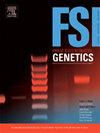Forensic pathological and genetic landmarks in sudden cardiac death in the young: An update
IF 3.1
2区 医学
Q2 GENETICS & HEREDITY
引用次数: 0
Abstract
An episode of sudden death in a young individual is a dramatic event for family members but also a challenge for cardiologists, pediatricians, forensic pathologists and researchers. In the young population, most of sudden deaths are of cardiac origin, in particular due to hereditary cardiac disorders. The autopsy protocol includes a proper macroscopic heart examination and a comprehensive histological analysis. The identification of pathognomonic histopathologic findings may help to unravel the cause of death, but microscopic features are often non-specific and highly ambiguous. Negative autopsy leads to classify the decease as a sudden arrhythmic death syndrome despite concealed cardiomyopathies may be also suspected. The molecular autopsy helps to identify the pathogenic genetic alteration associated with the arrhythmogenic episode leading to the sudden cardiac death. Due to genetic diseases, clinical assessment and genotype-phenotype correlation of relatives is mandatory to early identification of family members at risk and thus adoption of preventive measures, especially in asymptomatic genetic carriers. Specialized teams must carry out a personalized interpretation, integrating all the autopsy findings along with the family history to obtain a conclusive cause of the sudden death. In this review we pretend to update these critical issues.
年轻人心源性猝死的法医病理学和遗传标志:最新进展
年轻人突然死亡对家庭成员来说是一个戏剧性的事件,但对心脏病专家、儿科医生、法医病理学家和研究人员来说也是一个挑战。在年轻人中,大多数猝死是由心脏原因引起的,特别是遗传性心脏疾病。尸检方案包括适当的宏观心脏检查和全面的组织学分析。病理组织学发现的鉴定可能有助于揭示死亡原因,但显微镜特征往往是非特异性和高度模糊的。阴性尸检导致将死亡归类为突然心律失常死亡综合征,尽管隐藏的心肌病也可能被怀疑。分子解剖有助于确定与导致心源性猝死的心律失常发作相关的致病基因改变。由于遗传病,临床评估和亲属的基因型-表型相关性是必要的,以便早期发现有风险的家庭成员,从而采取预防措施,特别是对无症状的遗传携带者。专业小组必须进行个性化的解释,将所有尸检结果与家族史结合起来,以获得决定性的猝死原因。在这篇评论中,我们假装更新这些关键问题。
本文章由计算机程序翻译,如有差异,请以英文原文为准。
求助全文
约1分钟内获得全文
求助全文
来源期刊
CiteScore
7.50
自引率
32.30%
发文量
132
审稿时长
11.3 weeks
期刊介绍:
Forensic Science International: Genetics is the premier journal in the field of Forensic Genetics. This branch of Forensic Science can be defined as the application of genetics to human and non-human material (in the sense of a science with the purpose of studying inherited characteristics for the analysis of inter- and intra-specific variations in populations) for the resolution of legal conflicts.
The scope of the journal includes:
Forensic applications of human polymorphism.
Testing of paternity and other family relationships, immigration cases, typing of biological stains and tissues from criminal casework, identification of human remains by DNA testing methodologies.
Description of human polymorphisms of forensic interest, with special interest in DNA polymorphisms.
Autosomal DNA polymorphisms, mini- and microsatellites (or short tandem repeats, STRs), single nucleotide polymorphisms (SNPs), X and Y chromosome polymorphisms, mtDNA polymorphisms, and any other type of DNA variation with potential forensic applications.
Non-human DNA polymorphisms for crime scene investigation.
Population genetics of human polymorphisms of forensic interest.
Population data, especially from DNA polymorphisms of interest for the solution of forensic problems.
DNA typing methodologies and strategies.
Biostatistical methods in forensic genetics.
Evaluation of DNA evidence in forensic problems (such as paternity or immigration cases, criminal casework, identification), classical and new statistical approaches.
Standards in forensic genetics.
Recommendations of regulatory bodies concerning methods, markers, interpretation or strategies or proposals for procedural or technical standards.
Quality control.
Quality control and quality assurance strategies, proficiency testing for DNA typing methodologies.
Criminal DNA databases.
Technical, legal and statistical issues.
General ethical and legal issues related to forensic genetics.

 求助内容:
求助内容: 应助结果提醒方式:
应助结果提醒方式:


